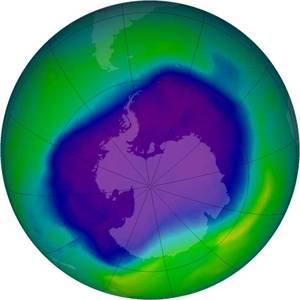Ozone Depletion and Behavioural Change - Planet Earth Online
Interview with
In May 1985 scientists discovered the hole in the ozone layer. Two years later, governments around the world signed up to the MontrealProtocol to phase out the use of the chlorofluorocarbons - CFCs - thatdamage ozone. So why can't a similar thing happen when it comes to climate change? Planet Earth's Richard Hollingham went to speak with Jonathan Shanklin, one of the original ozone hole discoverers...
Jonathan - We've got the data from Antarctica which I'd plotted up and one of the key things was that we could see something systematic going on in our data.
one of the key things was that we could see something systematic going on in our data.
Richard - So, let's look at this graph - it's plotted by hand, a time before computers would do this.
Jonathan - Drawn on paper with pencil and a ruler to draw the best fit line to the data, but the point is anybody can see that something is happening. You can see ever so clearly that ozone amounts are going down and that was really absolutely key, once you had something systematic then something must be causing it, and my question was what?
Richard - This is the Nature paper we've also got here, and this is interesting because figure 2 of the Nature paper again, obviously, originally draw by hand then printed, you made a correlation between this decline in ozone and CFCs?
Jonathan - Yes. There had been thoughts that CFCs could affect the ozone layer for some time but the predictions were that they should be affecting the ozone layer high above the tropics. What we actually found was low above the Antarctic, quite a different place, but because there's been this expectation that chlorofluorocarbons could affect the ozone layer we thought, well this is probably the case and so when we plotted the graph we guided the eye by choosing the right scale so that at a glance you could see that there was a correlation between ozone amounts declining and the CFC amounts going up.
Richard - Okay, so the Montreal Protocol,a huge success in terms of environmental treaties, just getting that done two years after your discovery. Why then is there still an ozone hole over the Antarctic and now, what many people are describing as an ozone hole over the Arctic as well?
Jonathan - The Montreal Protocol has been incredibly successful. Today every single one of UN member states have signed up to it, but these CFCs are very very stable. They persist in the atmosphere a long time and although it's very clear that we've passed the maximum in the atmosphere, the amounts are going down, the treaty is working there is still so much around that ozone destruction can take place whenever the conditions are suitable. Now, in the Antarctic they're suitable every year - this year we've had one of our deepest and largest ozone holes actually on record. Also the conditions were suitable in the Arctic this year.
Richard - So all this points to much greater complexity, Jonathan, than perhaps you first imagined when you plotted this very simple graph.
Jonathan - It is a lesson in how quickly we can change our atmosphere. This happened in the space of about a decade between it being detectable to it being a full blown ozone hole.
Richard - Let's go back then to this paper, this graph and the Montreal Protocol which is given as an example a huge success when it comes to these sorts of treaties. Is that repeatable when it comes to global warming, to climate change?
Jonathan - There are differences. With the CFCs, just about everybody was on side, the manufacturers were quite happy to switch to a different product, it was very easy to switch to a different product. Also, the public don't like holes, so calling it an ozone hole that must be bad just because of the name and also the link between increased ultraviolet light and cancer. Again, cancer is one of our real bains of today's society, so if something is causing cancer we've got to get rid of it. So everything worked in favour of doing something about the ozone hole.
With the greenhouse gases it is much harder - greenhouse warming sounds nice, but it will take a very big change in lifestyle for individuals to reduce their dependence upon substances that get converted into carbon dioxide and also the manufacturers, the industry, the oil industry in particular is rather reluctant to stop selling oil. There's no cheap alternative that could be widely sold. I think we will be lucky to get a treaty that's effective like the Montreal Protocol was.










Comments
Add a comment